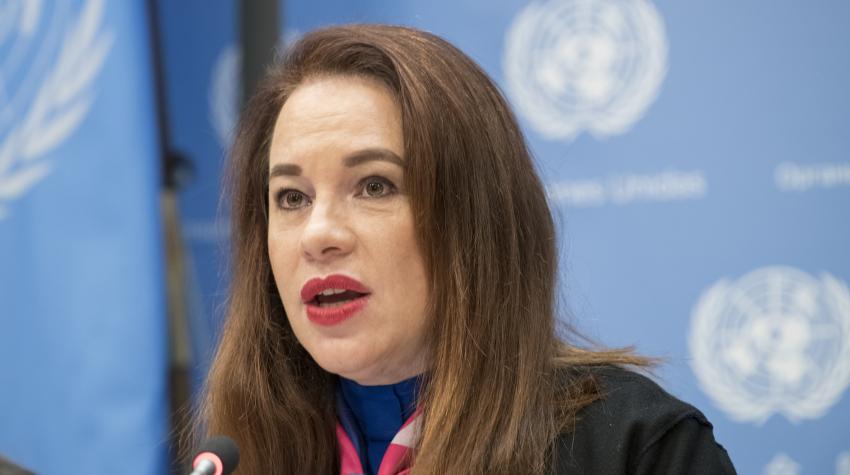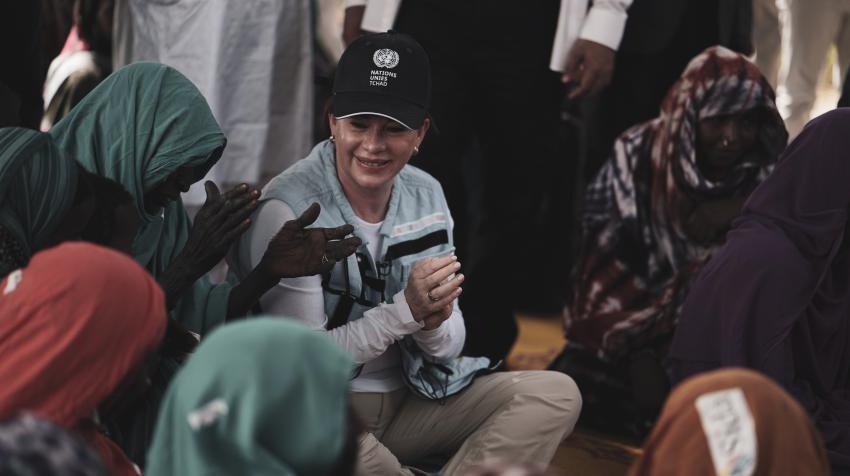This year’s International Day of Peace, observed on 21 September, should start by honouring all the lives that have been lost due to the COVID-19 pandemic. Peace is not only the synonym of harmony, security and well-being, but also a product of equality and non-discrimination. Peace, as we understand it, simply cannot exist if we exclude the welfare of women and girls, who comprise half of the world’s population.
Historically, women have been the most affected by war and conflicts. Yet they have also been among the most engaged in fruitful peace processes. In 1915, long before the Charter of the United Nations was signed in 1945, the Women’s International League for Peace and Freedom was shaped as a response to the horrors of the First World War. At the time, more than 1,200 women were advocating for the right of women to take part in decision-making in peace and security affairs.
In 1969, the Commission on the Status of Women (CSW), questioned whether women and children should be afforded special protection during conflicts. Five years later, in 1974, the United Nations General Assembly adopted the Declaration on the Protection of Women and Children in Emergency and Armed Conflict. Between 1975 and 1995, a series of United Nations World Conferences on Women marked a significant turning point: women were recognized as powerful agents for peace. In 1975, the first demands for greater women’s participation in security were formally presented at the World Conference of the International Women's Year, held in Mexico City. Ten years later, in Nairobi, women’s perspectives were considered in multidimensional operations aimed at strengthening world peace. Finally, in Beijing in 1995, the Fourth World Conference on Women demanded that more women be placed at the highest levels of decision-making in peace and security.
United Nations Security Council resolution 1325 (2000): The landmark of women’s rights in maintaining peace and security
Women are disproportionately affected by the proliferation and use of weapons. While men are overwhelmingly responsible for the misuse of small arms and account for 84 per cent of violent deaths, including homicides and in armed conflicts, every two hours a woman dies due to gender-based domestic and sexual violence, especially through the use of small arms.
United Nations Security Council resolution 1325 (2000) on women, peace and security was one of the crowning achievements of the global women’s movement, and one of the Council’s most salient decisions. The resolution, adopted in 2000, recognizes the impact of conflict on women and girls, and reaffirms their important role in peace and security, addressing four intertwined pillars: participation, protection, prevention, and relief and recovery.
Gender equality is a stronger predictor of a State’s peacefulness than its level of democracy or gross domestic product.
Over the next 15 years, seven1 further Security Council resolutions addressed critical issues on women, peace and security. These helped to recognize conflict-related sexual violence as a tactic of warfare; increase women’s participation in peace operations; demand zero-tolerance for peacekeepers with regard to gender-based sexual exploitation and abuse; deploy Women Protection Advisers; and acknowledge the critical role of women’s organizations in the protection of human rights.
Yet despite great progress in the last 20 years, there are still implementation gaps at the regulatory and budgetary levels. Today, only 41 per cent of United Nations Member States have adopted a National Action Plan for Security Council resolution 1325 (2000), and only 22 per cent of these plans included a budget at the time of adoption. Fewer than 20 per cent of all Security Council resolutions in 2018 contained references to the importance of women and the need to ensure fundamental rights and freedoms for civil society, women’s groups and women human rights defenders. The continued marginalization of women in these discussions is a major shortfall that affects the quality, swiftness and sustainability of decisions regarding peace and security.
There is no sustainable peace without the full and equal participation of women
We are acutely aware that peace is more than the absence of war. Sustaining peace encompasses not only activities aimed at preventing the outbreak and escalation of violence, and the continuation and recurrence of conflict, but also addresses the nature of exclusion, discrimination, injustice, inequality and structural violence.
Today, women make up only 4.2 per cent of military personnel in United Nations peacekeeping missions and only 29 per cent of recent peace agreements include gender-related provisions, compared to 45 per cent in 2013. While 35 million women need humanitarian aid, at least 1 in 5 refugee women experience sexual violence and only 28 per cent of humanitarian needs assessments articulate a gender-based differentiated impact.
Gender equality is a stronger predictor of a State’s peacefulness than its level of democracy or gross domestic product. Where gender equality is the guideline, a State is less likely to use violence, abuse human rights, commit torture, experience civil conflict or go to war. According to the Global Peace Index, over the past year, peacefulness deteriorated the world over for the ninth time in the last 12 years. Thus, it is not a coincidence that countries like Iceland remain the most peaceful and champions on gender equality.

Twenty-five years after the landmark Beijing Declaration, and despite significant progress, women’s political participation remains the greatest gender disparity. Today, women comprise less than a quarter of the world’s elected politicians. Eighty-five out of 193 countries have never had a woman as Head of State or Government; women represent only 21 per cent of ministers in cabinets; and in some countries, women are still not represented.
Although women’s participation in parliament has increased from 11.2 per cent to 24.9 per cent in the last two decades, it is still far from the one-third threshold considered the minimum needed to shape law and policy for gender equality. At these rates, the global gender gap would not close for 100 years.
Objectives for women’s representation are far from being achieved, and the political participation of women continues to be highly discouraged. Women are doubly targeted by record levels of political violence. The rise of misogynistic, sexist and hate speech in political environments contributes to increasing violence against women.
From COVID-19 to the climate crisis: Women, peace and security agenda challenges
Amid the most profound and devastating crisis since the Great Depression, we have witnessed women’s leadership in action. From decision-making to frontline services, women have tackled the COVID-19 outbreak more efficiently. First-hand evidence has shown that there are fewer cases of contagion and lower death rates when women are involved and empowered. Yet while the world battles this pandemic—and despite a call for a global ceasefire—we continue to see high levels of conflict, violence and instability. We are also still fighting the existential crisis of climate change which, if unaddressed, will increase the risk of violent conflict, create threats to human security, and challenge conflict recovery and peacebuilding.
As the world strives to rebuild in the post-COVID era, it is time to address the root causes of gender inequality and “build back better” with an equality and women’s rights lens.
In 2015, for the first time, the Security Council linked climate change to the women, peace and security agenda.2 Pandemics, increasing numbers of refugees and internally displaced persons, as well as the rise of violent extremism, were considered key factors in the rapidly changing global landscape for peace and security. The connection is evident. Climate change undermines human security. Violent conflicts caused by climate change can exacerbate poverty, discrimination, inequality, gender-based violence, food insecurity and forced migration. These challenges require a more comprehensive approach with the meaningful participation of women at all levels, from preventing climate-related risks to the climate negotiation processes. While women are, and will be, the most affected by climate-related conflicts—especially indigenous women and women with disabilities—they are and should be agents of resilience-building and transformation.
As the world strives to rebuild in the post-COVID era, it is time to address the root causes of gender inequality and “build back better” with an equality and women’s rights lens. To do so, we need to prioritize conflict prevention and actions aimed at emerging threats to sustaining peace. We need to ensure a true implementation of the women, peace and security agenda as one of the main global commitments to conflict prevention, sustaining peace, sustainable development and human rights.
COVID-19 is a setback for the 2030 Agenda and the Sustainable Development Goals. Growing inequalities are exacerbated, gender equality and women’s rights have been disproportionately affected, and fragile States could be devastated by conflicts and civil wars. This stormy scenario, however, can be seen as an opportunity to redouble efforts to counter the impacts of inequality and exclusion, a chance to push the reset button in the fight against poverty and end the climate crisis. It is not a matter of volunteerism but rather of concerted, firm, committed action on the transformative redistribution of wealth and power, and investment in a wiser and greener environment, to mention a few. To make sure that we rise to the challenges, old and new, we need a “New Social Contract" that ensures women’s equal and meaningful participation at the forefront of peace, security and humanitarian action, not only to protect women’s rights and dignity but also to ensure that they are key actors in building and sustaining peace.
Three international milestones converge this year: the 75th anniversary of the signing of the Charter of the United Nations; 25 years since the adoption of the Beijing Platform for Action; and 20 years since the women, peace and security agenda was established with the unanimous adoption of Security Council resolution 1325 (2000), reinforcing the critical role of women in preventing conflict and sustaining peace. The best way to honour these historical landmarks is to close the implementation gap and ensure that we walk the talk; and that women’s voices and agency are part of every effort to build back better, to construct a world that is more peaceful, fairer and free of injustice, violence, poverty and inequalities. Peace should not be simply an ideal or a utopian dream, but rather an inspiring and driving force for action and transformation.
Notes
1 S/RES/1820 (2008); S/RES/1888 (2009); S/RES/1889 (2009); S/RES/1960 (2010); S/RES/2106 (2013); S/RES/2122 (2013); S/RES/2242 (2015);
2 S/RES/2242 (2015).
18 September 2020
The UN Chronicle is not an official record. It is privileged to host senior United Nations officials as well as distinguished contributors from outside the United Nations system whose views are not necessarily those of the United Nations. Similarly, the boundaries and names shown, and the designations used, in maps or articles do not necessarily imply endorsement or acceptance by the United Nations.




